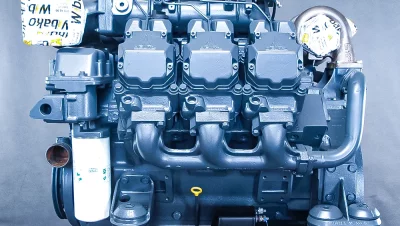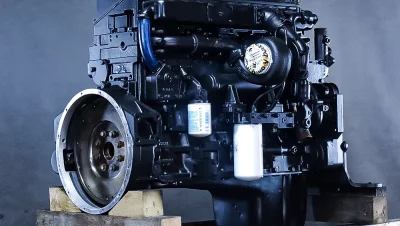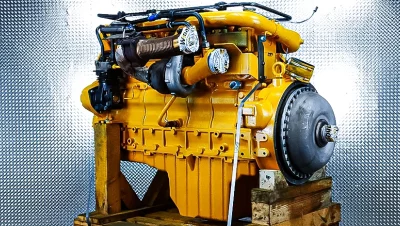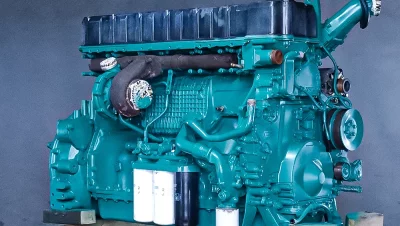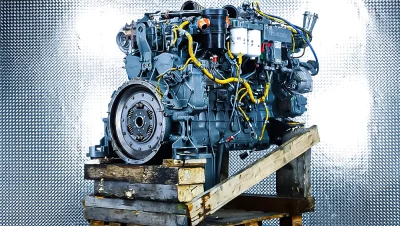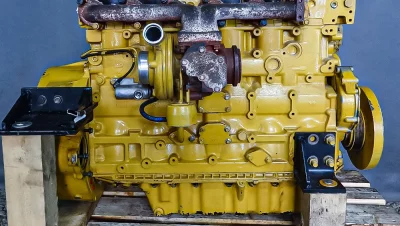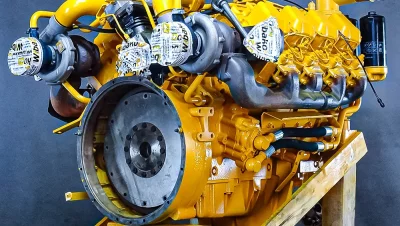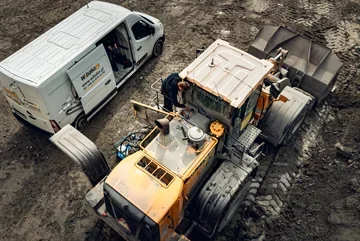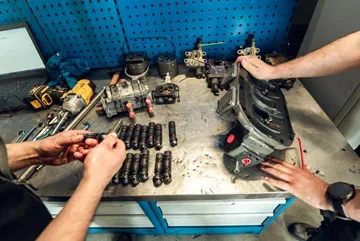Comprehensive repair of the Deutz TCD2013 L06 2V engine in the Sennebogen 835M wheeled loading machine
Introduction
Our WIBAKO service received a wheeled loading machine Sennebogen 835M, used in intensive material handling operations. The machine is equipped with a modern and highly regarded for its durability and economic operation diesel engine Deutz TCD2013 L06 2V. This unit is one of the most popular engines used in scrap handling, aggregates, and recycling plants. The owner contacted our service due to a noticeable drop in power, increased fuel consumption, and white smoke during startup, which suggested problems with the combustion system or cylinder head sealing.
After a preliminary analysis, we decided to perform a full diagnostic of the Deutz unit. The DEUTZ engine manufacturer is a global leader in the design of industrial diesel units, where durability and full resistance to prolonged loads are a priority. Meanwhile, the Sennebogen brand is known for its robust and highly efficient loading machines, where the drive system often operates under conditions of continuous variable load. The combination of these technologies requires enormous precision and experience from the service – which is provided by our WIBAKO team.
Preliminary diagnostics
The symptoms in the machine suggested a possible cylinder head crack or damage to the head gasket. Typical symptoms include coolant loss without visible leaks, increased smoking, and uneven operation after a cold start.
Basic diagnostics
In the first stage, we performed:
- CO2 test in the cooling system,
- compression check on all cylinders,
- exhaust gas analysis for the presence of water vapor,
- endoscopic inspection of the combustion chamber interior.
The results clearly indicated the presence of exhaust gases in the cooling system – confirming the suspicion of head damage.
Final diagnostics
To confirm the preliminary results, after disassembly, we performed a high-pressure test of the head and a leak test in a water bath. During these tests, microcracks appeared in the area of the valve seat of one of the cylinders – completely excluding further operation without repair.
Disassembly of the Deutz TCD2013 L06 2V engine from the machine
The disassembly was carried out near the city of Katowice, where the machine was operating. According to the procedure, a crane provided by the client was used to remove the engine. Our technicians disconnected all fuel lines, electrical installation components, intake piping, and cooling hoses, while securing them against contamination.
The engine was prepared for transport and transported to our headquarters in Kojszówka – where we perform full verification and rebuilding of units. The disassembly process also included detailed photographic documentation to recreate all connections during reassembly.
Engine verification in the workshop
On-site, we began the full verification process of the power unit. The engine was disassembled into its components, and all parts were cleaned in water and chemical washers.
Verification results
- Head: microcracks in the area of the valve seats, leaks during the water test.
- Crank-piston system: signs of overheating on the sleeves, noticeable wear on the rings.
- Crankshaft: acceptable measurement values, no need for grinding.
- Injectors: differences in doses, need for regeneration.
- Turbocharger: slight lateral play – regeneration ordered.
Engine repair process
Crank-piston system
As part of the rebuilding, pistons, sleeves, rings, and connecting rod bearings were replaced. The connecting rods were verified for twisting and possible microcracks. All results were within the norm, so after cleaning and measurements, the components returned to operation.
Engine head
The head underwent regeneration including planning, replacement of valve guides, seats, and valves. We then conducted a leak test – the head after repair achieved full tightness and was approved for assembly.
Fuel system
The injectors were sent to the testing bench – a full regeneration was performed. The injection pump was checked at an external facility cooperating with WIBAKO. After regeneration, all components achieved factory-compliant parameters.
Engine accessories
The turbocharger regained full efficiency after regeneration, while the alternator and starter were inspected and cleaned. We also replaced all seals, hoses, and consumable parts.
Professional assembly of the engine
After completing the repairs, we began the process of assembling the engine. According to the procedure, all adjustment and assembly screws were tightened to specifications compliant with Deutz. Each stage was documented. The assembled unit was preliminarily filled with oil and operating fluids.
Engine test on the dynamometer
As one of the few companies in Poland, we have a full-size engine dynamometer for testing industrial units. This is a key tool that allows for the verification of engine parameters under load before installation in the machine.
The Deutz TCD2013 L06 2V engine operated at low load (20-30 percent of nominal power) for the first 16 hours, allowing for proper seating of the pistons, rings, and sleeves. After the initial break-in period, we proceeded to full-load tests, during which we repeatedly achieved values close to factory specifications.
The WIBAKO dynamometer allows for the reading of:
- torque,
- actual power,
- oil pressure,
- combustion parameters,
- stability of operation under sudden load,
- operating temperatures.
All results confirmed the full efficiency of the unit after the repair, so the engine was approved for reinstallation.
Installation of the engine in the Sennebogen 835M machine
The installation was again performed at the client's site, at the machine's working location near Katowice. The installation process is as important as the regeneration itself, which is why we dedicated over 300 words to describe it in detail.
The engine was introduced into the engine compartment with the help of a crane provided by the client. Our technicians positioned the unit in line with the frame, paying special attention to the proper fitting of the engine mounts. We then began connecting all systems – fuel, cooling, intake, electrical, and control hydraulics.
We replaced the complete set of air hoses, checked all clamps, connectors, and joints for tightness. Each element of the fuel system was bled. The cooling system was filled with fresh fluid and a pressure test was performed before starting.
After completing the installation, we proceeded to tests in the presence of the machine operator. The engine was started, and we then checked:
- absence of leaks,
- stability of operation at various RPM ranges,
- operation of the Visco fan,
- working temperatures and pressures,
- correctness of cooperation with the machine's hydraulic system.
After successfully passing the final tests, we signed the installation protocol.
Engine maintenance after repair
We recommend performing the first inspection after 50 hours of operation – this includes not only filter replacement but also a detailed check of accessories, tightness, and the condition of connections. Subsequent inspections should be performed every 250 hours or at most every 3 months.
Machines that use the Deutz TCD2013 L06 2V engine
This engine is used, among others, in:
- Sennebogen 818, 821, 830, 835 loading machines,
- Atlas wheeled loaders,
- selected models of Komatsu dumpers and machines,
- industrial machines used in recycling and logistics.
Summary
The conducted repair restored full efficiency to the Sennebogen 835M machine. The Deutz TCD2013 L06 2V engine operates stably, achieves factory parameters, and has been thoroughly tested on the WIBAKO dynamometer. Thanks to professional assembly and verification, the client received a machine ready for further heavy operation. We remind you of the inspection after 50 hours.
Deutz engine service
Contact us if your machine requires engine repair or regeneration. We offer comprehensive service, an engine dynamometer, and a mobile service team available throughout Poland.




